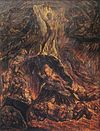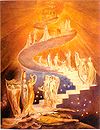- Descriptive Catalogue (1809)
-
The Descriptive Catalogue of 1809 is a description of, and prospectus for, an exhibition by William Blake of a number of his own illustrations for various topics, but most notably including a set of illustrations to Chaucer's Canterbury Tales, this last being a response to a collapsed contract with dealer Robert Cromek.
Having conceived the idea of portraying the characters in Chaucer's Canterbury Pilgrims, Blake approached Cromek with a view to marketing an engraving. Knowing that Blake was too eccentric to produce a popular work, Cromek promptly commissioned Thomas Stothard to execute the concept. When Blake learned that he had been cheated, he broke off contact with Stothard, formerly a friend. He also set up an independent exhibition in his brother's haberdashery shop at 27 Broad Street in the Soho district of London. The exhibition was designed to market his own version of the Chaucer illustration, along with other works. As a result he wrote his Descriptive Catalogue of 1809, which contains what Anthony Blunt has called a "brilliant analysis" of Chaucer. It is regularly anthologised as a classic of Chaucer criticism.[1] It also contained detailed explanations of his other paintings.
The price of the Catalogue was 2s 6d (one eighth of a pound sterling), and of admission to the exhibition 1s (one twentieth of a pound sterling); the usual price for exhibitions at the period. At the time a minor house servant might be paid ten pounds per year. An Index to the Catalogue was free with admission to the exhibition.
The Preface to the Catalogue begins with a diatribe against "the Venetian" Correggio and Titian. It concludes (using the conventional spellings of his day):
Colouring does not depend on where the Colours are put, but on where the lights and darks are put, and all depends on Form or Outline, on where that is put; where that is wrong, the Colouring never can be right; and it is always wrong in Titian and Correggio, Rubens and Rembrandt. Till we get rid of Titian and Correggio, Rubens and Rembrandt, We never shall equal Rafael and Albert Durer, Michael Angelo, and Julio Romano.
Although now lost, The Ancient Britons was the most sensational of the works displayed and with dimensions of some 10 ft by 14 ft, was the largest work ever executed by Blake. The painting depicted the last battle of King Arthur against the Romans.
The exhibition was very poorly attended, with none of the temperas or watercolours sold and was described as "a dead failure". There was ony one review, in The Examiner, which was hostile.
Between April and October 2009 many of the works displayed at the original exhibition were put on display together once more at Tate Britain.[2]
Works included
The Index to the Catalogue is as follows:-
Image Title Number Notes 
I The Spiritual form of Nelson guiding Leviathan 
II The Spiritual form of Pitt guiding Behemoth 
III The Canterbury Pilgrims, from Chaucer Shown is Blake's engraving based
on the painting, rather than the painting itself
IV The Bard, from Gray Lost V The Ancient Britons VI A Subject from Shakspeare [sic] VII The Goats VIII The Spiritual Protector 
IX Satan calling up his Legions, from Milton X The Bramins [sic] - A Drawing a depiction of Charles Wilkins consulting Brahmins while making the first English translation of the Bhagavad Gita. 
XI The Body of Abel found by Adam and Eve, Cain fleeing away - A Drawing [Genesis 4:8] 
XII Soldiers casting Lots for Christ's Garment - A Drawing [John 19:30–31] 
XIII Jacob's Ladder - A Drawing [Genesis 28:12] 
XIV Angels hovering over the Body of Jesus in the Sepulchre - A Drawing [John 20:12] XV Ruth - A Drawing [Ruth 1:16] 
XVI The Penance of Jane Shore - A Drawing References
Sources
- ed. Geoffrey Keynes: "Blake: Complete Writings", Oxford University Press, 1989. ISBN 0-19-281050-2. Based on material originally published by the Nonesuch Press, 1948 and 1957, and subsequently transferred to OUP.
William Blake Literary works Early writingsPoetical Sketches · An Island in the Moon · All Religions are One · There is No Natural ReligionSongs of InnocenceIntroduction · The Shepherd · The Ecchoing Green · The Lamb · The Little Black Boy · The Blossom · The Chimney Sweeper · The Little Boy lost · The Little Boy Found · Laughing Song · A Cradle Song · The Divine Image · Holy Thursday · Night · Spring · Nurse's Song · Infant Joy · A Dream · On Another's SorrowSongs of ExperienceIntroduction · Earth's Answer · The Clod and the Pebble · Holy Thursday · The Little Girl Lost · The Little Girl Found · The Chimney Sweeper · Nurse's Song · The Sick Rose · The Fly · The Angel · The Tyger · My Pretty Rose Tree · Ah! Sun-Flower · The Lily · The Garden of Love · The Little Vagabond · London · The Human Abstract · Infant Sorrow · A Poison Tree · A Little Boy lost · A Little Girl Lost · To Tirzah · The School Boy · The Voice of the Ancient BardOtherTiriel · The Book of Thel · The Marriage of Heaven and Hell · The French Revolution · Visions of the Daughters of Albion · The Book of Urizen · The Book of Ahania · The Book of Los · The Four Zoas · Milton a Poem · Jerusalem The Emanation of the Giant Albion ·The Auguries of Innocence · The Mental Traveller · The Crystal CabinetMythology Art Paintings and printsRelief etching · Engravings for Original Stories from Real Life · The Ancient of Days · The Night of Enitharmon's Joy · Newton · Nebuchadnezzar · Illustrations for Night Thoughts · The Four and Twenty Elders Casting their Crowns before the Divine Throne · Illustrations of Paradise Lost · A Vision of the Last Judgment · Descriptive Catalogue · The Great Red Dragon Paintings · Pity · The Ghost of a Flea · Illustrations of On the Morning of Christ's Nativity · The Wood of the Self-Murderers: The Harpies and the Suicides · Illustrations of the Book of Job · The AncientsCriticism and scholarship Scholars and criticsScholarly worksLife of William Blake · Fearful Symmetry · A Blake Dictionary: The Ideas and Symbols of William Blake · Blake: Prophet Against Empire · Witness Against the BeastWikimedia Categories:- 1809 books
- Artists' books
- Art by William Blake
- Art exhibitions
- Museum books
Wikimedia Foundation. 2010.

